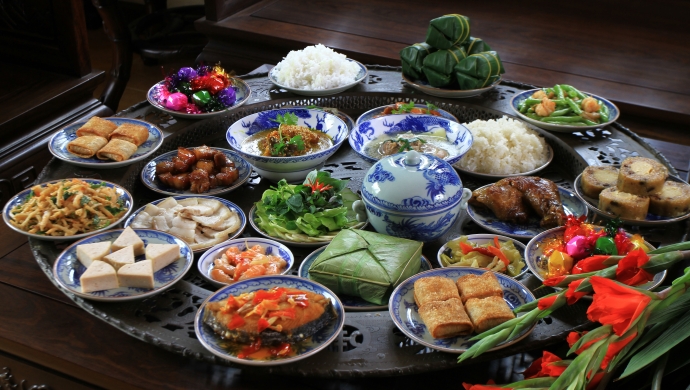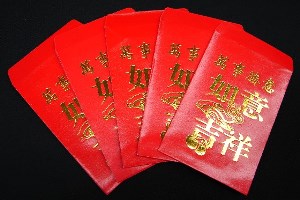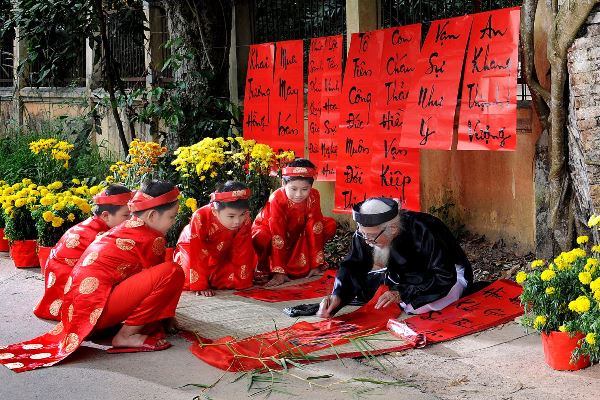For people of Vietnamese heritage, no traditional holiday is bigger than Têt, the lunar calendar New Year’s, which is also celebrated in other Far East countries (Mongolia, China, Korea, Japan). The exact date varies from year to year, usually between mid-January and mid-February. In 2018, Têt will usher in the new Year of the Dog on Friday, February 16.
Viêt-Nam is unique among all the countries that celebrate the lunar calendar New Year’s (aside from southern China) in that it is situated in the tropics. And so when New Year’s rolls around, while most of those places still find themselves deep under winter’s snow—PyeongChang comes to mind—Viêt-Nam alone welcomes Têt as the return of spring. Fruit trees and flowers are in bloom, and flower markets sprout up on street corners weeks before the big day, bursting with colors that herald a new cycle of seasons.
The Vietnamese expression “ăn Têt” literally means “eating Têt,” because New Year’s is always celebrated with the most elaborate feasts that one’s situation can afford. The delicious foods, most of which used to be prepared at home, are first presented on the familial altar in remembrance of the ancestors, before being partaken by the family and guests. Along with tiên lì xì (lucky money in red envelopes), these scrumptious meals are easily the favorite Têt traditions among children.



Recently, a long lost art form is making a comeback: calligraphy. In centuries past, around Têt time people would pay calligraphists to write good wishes in Chinese characters on strips of lucky-red paper, which they would hang around their houses or beside their ancestral altars. By the early twentieth century, however, Chinese writing fell out of favor and was quickly replaced by the Vietnamese alphabet, and the traditional calligraphy just disappeared, apparently forever. But it seems to have reemerged in recent years, but using the alphabet instead, and scripted in flowery cursive to make the characters resemble Chinese. It’s a sentimental throwback to the olden days, more for decorative purposes than to bring good luck as in the past.

Aside from the traditional aspect of the lunar calendar New Year’s, 2018 Têt also marks the 50th anniversary of a tragic event in Vietnamese history: the 1968 Têt Offensive. That year, the Communists violated a 36-hour ceasefire and launched a surprise attack all over South Viêt-Nam. They eventually failed in their blatant attempt to take over the South, but not before wreaking tremendous havoc and death on the innocent population at the most sacred time of year. To this day, many families still mourn the untimely passing of their loved ones during that bloody chapter of the war.
And so, on this special day when we customarily remember and pray for the deceased, I say my prayers for all the victims of senseless massacres, from half a century ago as well as now.



Thank you Jim, for telling us this…..
My pleasure, John. I’m glad you enjoyed it.
Love this, Jim! I learned much about TET by reading your book. I recently read ‘Fire Road’ about the “napalm girl” which describes her injuries, but also how the government marketed and manipulated her. She also discussed Tet and her former religion, Cao Dai, how the war effected her family, and her eventual escape. Such incredible stories!
Keep sharing!
Hi Kathy! So nice to hear from you. Lunar New Year’s is such a wonderful time with lovely traditions and family memories, but TET has forever taken on the tragic connotations of war since that bloody event of 1968. Really sad.
What a beautiful post, and a powerfully emotional close. Happy New Year, my friend.
Thank you very much, Lynne! So good to hear from you, and I’m thrilled you enjoyed the post. Happy Lunar New Year to you!